While the internet has been a boon for detailed information about musical genres and artists, there is one problem: often these pages disappear after a few years. This can be because the creators forget to pay their bill for hosting, or they lose interest, or some other development that sends the pages into outer space. A few years ago Sholto Duncan of New Zealand’s National Library wrote a piece on this topic for AudioCulture: “The Lost Websites”.
Luckily, the National Library has come up with a deft solution: “harvesting” these important New Zealand websites. While they are active, the Library copies them and makes them available on its website. At the Library’s site, the pages they harvest may be inactive – that is, some of the internal links may not work – but it’s better than losing all that information that was once published with love and scholarship.
Two crucial websites on New Zealand music history have recently been harvested: New Zealand Folk Song, and Memories of New Zealand Musicians. Nick Bollinger took a deep dive into both sites and shares some of his discoveries.
--

In 2021 John Archer (pictured at left) was surprised by a dramatic spike in visits to a page on his website, New Zealand Folk Song. His entry on a 19th century sea shanty ‘Soon May The Wellerman Come’, one of hundreds of New Zealand folk songs detailed on the site, had received 10,000 visits in a week, where it had seen virtually none in the whole of the previous year. What was going on?
His site was experiencing the ripple effects of a recent craze for sea shanties on the video hosting platform TikTok, which had started when a postman from Glasgow had uploaded his version of the ‘Wellerman’ song. The algorithm had kicked in and, in typical TikTok fashion, the internet was now awash with new interpretations of the old folk song, the subject of which Archer had traced back to employees of the Weller Brothers of Sydney who supplied provisions to whaling stations in New Zealand in the 19th century. Archer’s site was being consulted for lyrics, music and meanings.
Archer, who had recently turned 80, was not familiar with TikTok, but he took this unexpected convergence with global youth culture in his stride. As it turns out, the ‘Wellerman’ page – which has now seen upward of 100,000 visits – is not even the most visited page on his site. That would be ‘Tika Tonu’, the iconic Hawke’s Bay haka that received a quarter of a million hits after an emotional video of the action chant being performed at a wedding featured in an overseas news item, sending people around the world looking to find out its meaning.
New Zealand Folk Song – which is still online, as well as being archived by National Library – is a combination songbook, encyclopaedia and instruction manual. It’s a rich resource for anyone with an interest in songs in which New Zealanders speak about themselves. These range from sea shanties to haka, bush ballads to pop hits. The songs are all indexed alphabetically by title, alongside which is a brief and often whimsical description of its theme, reminiscent of the newspaper-style headlines with which Harry Smith, the great American musicologist, identified the songs in his definitive and influential Anthology of American Folk Music.
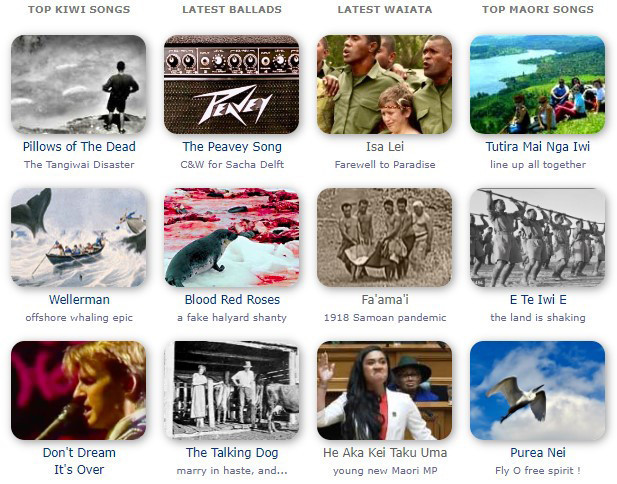
Thumbnails of topics on NZ Folk Song website.
Descriptors of some well-known songs on Archer’s site include “troopship dreams” (‘Blue Smoke’), “John Rowles’ sister” (‘Cheryl Moana Marie’), “Save the beer!” (‘The Day the Pub Burned Down’), “OE to find ID”(‘Where is My Wild Rose’), and “My Slasher is Rusty” (‘The Dying Bushman’). Click on the song’s title and you’ll be taken to a page with the lyrics, chords and much background information on the song, its origins, significance and composer – if known.
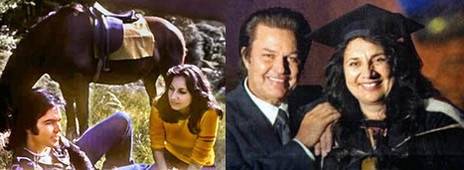
John Rowles and his sister Cheryl Moana Marie, in the early 1970s, and the 2000s.
Archer’s interest in songs goes back to the years he spent growing up in the rural village of Mangamahu, northeast of Whanganui. He heard children’s songs on the weekly Broadcasts to Schools; popular songs of the day on 2ZB, including some adapted from folk songs such as ‘Goodnight Irene’ and ‘So Long It’s Been Good To Know You’, and older tunes his Aunty May would play on the piano from sheet music. Around age 12 he taught himself harmonica and ukulele. At a Catholic high school he learnt Gregorian chants. After training as a Marist brother and teacher, he transferred his ukulele chord knowledge to the guitar “and spent hours after First XV matches on Saturday evenings singing all the 60s and 70s hit parade songs with all the mostly Polynesian parents. I thought that was ‘folk singing’. I had become overworked, alienated and burnt out, and bashing the guitar strings was very therapeutic.”
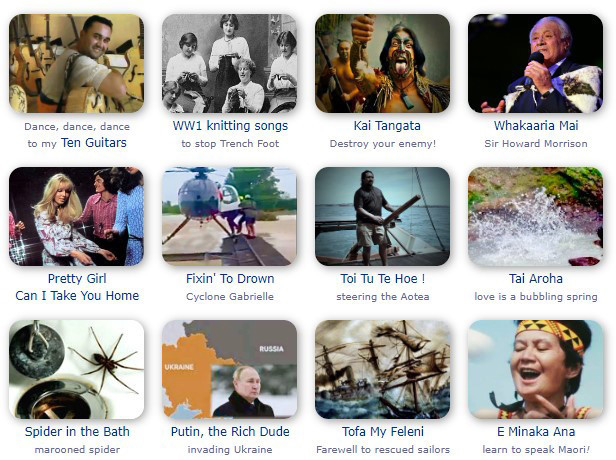
More thumbnails of topics on the NZ Folk Song website.
In 1979 he left “the brothers” and took a job at Massey University in Palmerston North. “I went along to the Palmerston North Folk Club on Friday nights for more singalongs. I was very surprised to find them singing and guitaring American blues and English folk ballads. They were songs I had never heard of before. ‘So if you can’t join ’em, beat ’em,’ I thought, and I started composing my own. I wrote some clunkers at first but I did come up with a really good one about my brother-in-law’s obsessive wheat-growing.
“My fellow club members never said a word about how bad my latest emotionally overdone ‘masterpiece’ was, but would simply ask heartily, ‘OK John, now give us your tractor song!’ I eventually learnt to write from my own experience.”
John Archer
launched the ‘New Zealand Folk Song’ website in 1998
He launched the New Zealand Folk Song website in 1998, initially to share material he had gathered as a personal project to examine how Pākehā culture is “reflected in the way we write, select and modify the songs we sing.”
This involved creating a database of song lyrics, collected at first from the singing of those in his community when he was growing up; later from the singing he had heard at folk clubs and festivals. He chose songs which had been requested, sung or recorded by many people, or generally reflected New Zealand events, customs and attitudes, and could be sung by an amateur with minimal accompaniment. He also chose new songs for the site from email suggestions, and from his own site’s search engine, which “emailed me a list of all the searches made in the past week.”
He has never been too bothered by strict definitions of what a folk song is. Essentially, he says, it is the music of the folk. “Folk are a group of people forming a tribe or nation: the fisherfolk, the common folk, those town folk, ‘the old folk’s home’, ‘you young folk’. Folklore consists of songs and/or rituals, music and stories that enable members to see their identity and/or that express their communal emotions.”
Though he distinguishes pop songs from folk songs as “songs composed and sold to make money,” he acknowledges that sometimes a pop song or even an advertising jingle will strike a chord and become the signature song of a community or group. Hence you will find on the website such pop hits as Split Enz’s ‘Six Months In a Leaky Boat’ and The Mutton Birds’ ‘Dominion Road’ and well-known television commercials as the Chesdale Cheese ad (“We are the blokes from down on the farm …”) and John Hanlon’s ‘Damn the Dam’, the Pink Batts ad that became an environmental anthem.
“So there are folk-identity songs and folk-style songs. Sometimes one becomes the other. There are dozens of Pākehā ballads on the NZFS site that are not true folk songs which have undergone the ‘selection and modification and sung by many’ folk process, but they are someone’s creative pride and joy and tell of a slice of New Zealand life.”
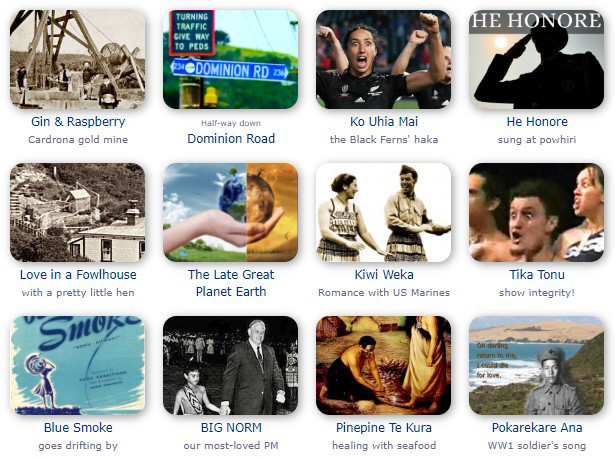
Wait, here's more thumbnails of topics on the NZ Folk Song website.
Sometimes an unexpected ballad become a folk-identity song. As an international example, Archer offers the 1960s Merle Haggard anti-protester broadside ‘Okie From Muskogee’, which found its own variant in regional New Zealand. “‘Okie From Muskogee’ was written by an outsider as a send-up joke song, then became a folk identity song, then a pop song. ‘Scourer from Mataura’ was written as a send-up of a send-up, and has become a proudly sung Southland (folk) identity song too.”
Archer researches the origins and meanings of the songs using a variety of methods, but if you’re imagining an early 20th century Cecil Sharp-style songcatcher, crisscrossing remote regions to transcribe ancient tunes remembered only by a few old singers, forget it. “They went around with pencil and pad, and then a recording cylinder phonograph, a wax disc gramophone, a tape recorder, etcetera,” says Archer, acknowledging those early folk collectors. “I’ve just interloaned library books, and searched Google, NZETC, Papers Past.
“The Pākehā songs are mostly about historical New Zealand events and have archaic slang words, and Google searches find more than enough details. I then use my school teacher experience to edit the details down to a level 10-14 year-olds can understand.”
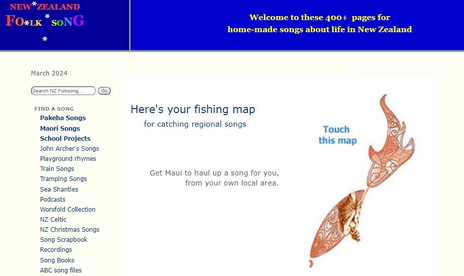
A New Zealand Folk Song home page.
The site was initially centred on Pākehā songs, but repeated emails asking for information about Māori songs prompted him to start a page devoted exclusively to waiata. It now features more than 200 waiata and has grown to become his most-visited page by far, with more than 2000 visits each week.
“Māori songs are more of a challenge, as when a schoolgirl emailed me two misspelt lines of a waiata that is not in any songbook I have, and asked for all the kupu and a translation and its background. Google is great for finding additional lines of a waiata, and variations of it, and there is a huge quantity of 1800s Māori books, newspapers and journals now searchable on the internet to find background details.”
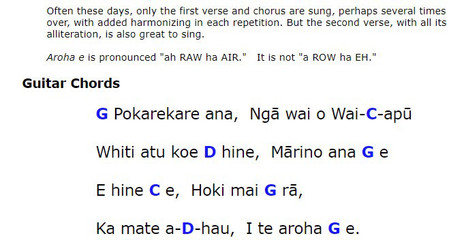
An excerpt from the Pokarekare page, Folksong.org.nz
Other features of the site include a ballad-writing instruction course. Archer began writing his own songs at the Palmerston North Folk Club in the late 70s and he shares some of his methods on the “Writing Ballads” page, which range from writing new words to old tunes, to using ideas that come to you in dreams.
His own songs are written from experience and often reflect his wry and satirical sense of humour. But one of his most powerful and well-travelled compositions was drawn from a tragic and traumatic event that affected the whole country and had a deep personal impact on Archer.
The Archers’ house at Mangamahu was on the edge of a cliff high above the Whangaehu River, downstream from where the railway line crossed the river at Tangiwai. On Christmas Eve 1953, a lahar from Mt Ruapehu came rushing down the Whangaehu River and swept away the Tangiwai railway bridge, just as the Limited Express was crossing it.
John recalls: “The engine and the first six carriages went into [the] torrent, at about the very moment as my parents were filling our pillow cases with Christmas presents, 60km downstream.
“We woke up Mum and Dad just before six o’clock on Christmas morning to show them what Father Christmas had brought us. And Dad turned on his bedside radio to see how many runs Australia had scored overnight in their test against England for the Ashes.
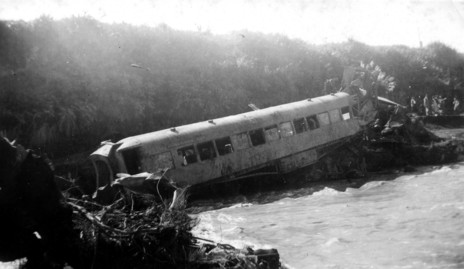
Tangiwai disaster, December 1953. From Fred Johnson albums, Tauranga City Libraries, photo 15-068
“Instead, he heard the announcement ‘A passenger train has been swept away in a flood at Sulphur Creek.’ He and mum left us to our toys and went out and across the road to the cliff above the river. When they got there they could hear a roaring noise up river and coming closer. Then a huge wall of liquid mud, 10 feet high, swept into view.
“When I joined them a few minutes later, I was struck by all the pillows being swept down by the torrent. Passengers on the Limited Express used to pay two shillings [20c] to hire a pillow, kapok filled, with a freshly washed white pillowslip on it, to make their overnight journey more comfortable. There were dozens and dozens of these white pillows floating past …”
In his song ‘Pillows of the Dead’, Archer records in stark detail his memories of that morning and its grisly aftermath. In 2021 he played the song in an episode of the television series National Treasures which links chosen objects to historic events. John presented as his chosen object some memoir notes, which he had written about witnessing the dead and their belongings washing up in the waters after the disaster. These notes eventually became the lyrics for his song. As Alex Casey noted in The Spinoff: “It’s a deceptively whimsical song, of a child trying to understand meaningless death and chaos on such a huge scale. So although the object is ostensibly John’s notes, it’s really the song which is the taonga, and having its creator sing it and speak to it is an extremely moving glimpse of living history.”
The song is one of several of Archer’s own that has its own page on the website. The 70th anniversary of the Tangiwai disaster in 2023 brought a fresh wave of visitors to the page. “It’s on its way to being a real folk song,” he says.
--
New Zealand Folk Song website (accessed 16 April 2024)
National Library archive of New Zealand Folk Song website:
NDHA harvest: oldest, 2008
NDHA harvest: newest, 2024
Read also: When the Pakeha Sings of Home
--